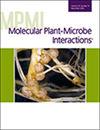Selin Ozdemir, Sobhan Bahrami Zadegan, Mst Shamira Sultana, Nicole Coffey, J Hollis Rice, Tarek Hewezi
求助PDF
{"title":"Regulation and Functions of Long Noncoding RNAs During <i>Meloidogyne incognita</i> Parasitism of Tomato.","authors":"Selin Ozdemir, Sobhan Bahrami Zadegan, Mst Shamira Sultana, Nicole Coffey, J Hollis Rice, Tarek Hewezi","doi":"10.1094/MPMI-10-24-0140-R","DOIUrl":null,"url":null,"abstract":"<p><p>Long noncoding RNAs (lncRNAs) are emerging as important regulators of various aspects of immune response and plant-pathogen interactions. However, the regulatory function of lncRNAs during plant-nematode interaction remains largely elusive. In this study, we investigated the differential regulation and function of lncRNAs during two different stages of tomato infection by the root-knot nematode <i>Meloidogyne incognita</i>. At the early stage of infection, 2,218 and 2,827 lncRNAs were regulated locally in the <i>M. incognita</i>-induced galls and systemically in the neighboring root cells, respectively. However, at the later stage of infection, the number of <i>M. incognita</i>-regulated lncRNAs was dramatically reduced, with only 49 lncRNAs being identified as differentially expressed. Differentially expressed lncRNAs were predicted to encode peptides with functionally annotated domains, providing insights into the potential roles of these peptides in regulating gene expression, RNA stability and splicing, and protein-protein-interactions. Among the differentially expressed lncRNAs, 55 were found to contain putative binding sites for 56 microRNAs (miRNAs). Overexpressing five of these lncRNAs significantly increased tomato resistance to <i>M. incognita</i>, supporting the functional importance of lncRNAs for establishing tomato-<i>M. incognita</i> interaction. Functional analysis of the target mimicry of lncRNAs towards miRNAs resulted in the identification of two novel regulatory modules involving miR47 and miR156e-5p and their targeted genes that regulate tomato responses to <i>M. incognita</i> parasitism. Taken together, our data provide novel insights into the transcriptional and posttranscriptional regulatory functions of lncRNA and open a new avenue to engineer crop plants with enhanced nematode resistance by leveraging the regulatory potential of lncRNAs. [Formula: see text] Copyright © 2025 The Author(s). This is an open access article distributed under the CC BY-NC-ND 4.0 International license.</p>","PeriodicalId":19009,"journal":{"name":"Molecular Plant-microbe Interactions","volume":" ","pages":"72-83"},"PeriodicalIF":3.4000,"publicationDate":"2025-02-01","publicationTypes":"Journal Article","fieldsOfStudy":null,"isOpenAccess":false,"openAccessPdf":"","citationCount":"0","resultStr":null,"platform":"Semanticscholar","paperid":null,"PeriodicalName":"Molecular Plant-microbe Interactions","FirstCategoryId":"99","ListUrlMain":"https://doi.org/10.1094/MPMI-10-24-0140-R","RegionNum":3,"RegionCategory":"生物学","ArticlePicture":[],"TitleCN":null,"AbstractTextCN":null,"PMCID":null,"EPubDate":"2025/2/22 0:00:00","PubModel":"Epub","JCR":"Q2","JCRName":"BIOCHEMISTRY & MOLECULAR BIOLOGY","Score":null,"Total":0}
引用次数: 0
引用
批量引用
Abstract
Long noncoding RNAs (lncRNAs) are emerging as important regulators of various aspects of immune response and plant-pathogen interactions. However, the regulatory function of lncRNAs during plant-nematode interaction remains largely elusive. In this study, we investigated the differential regulation and function of lncRNAs during two different stages of tomato infection by the root-knot nematode Meloidogyne incognita . At the early stage of infection, 2,218 and 2,827 lncRNAs were regulated locally in the M. incognita -induced galls and systemically in the neighboring root cells, respectively. However, at the later stage of infection, the number of M. incognita -regulated lncRNAs was dramatically reduced, with only 49 lncRNAs being identified as differentially expressed. Differentially expressed lncRNAs were predicted to encode peptides with functionally annotated domains, providing insights into the potential roles of these peptides in regulating gene expression, RNA stability and splicing, and protein-protein-interactions. Among the differentially expressed lncRNAs, 55 were found to contain putative binding sites for 56 microRNAs (miRNAs). Overexpressing five of these lncRNAs significantly increased tomato resistance to M. incognita , supporting the functional importance of lncRNAs for establishing tomato-M. incognita interaction. Functional analysis of the target mimicry of lncRNAs towards miRNAs resulted in the identification of two novel regulatory modules involving miR47 and miR156e-5p and their targeted genes that regulate tomato responses to M. incognita parasitism. Taken together, our data provide novel insights into the transcriptional and posttranscriptional regulatory functions of lncRNA and open a new avenue to engineer crop plants with enhanced nematode resistance by leveraging the regulatory potential of lncRNAs. [Formula: see text] Copyright © 2025 The Author(s). This is an open access article distributed under the CC BY-NC-ND 4.0 International license.
番茄黑僵菌寄生过程中长非编码 RNA 的调控与功能
长非编码 RNA(lncRNA)正在成为免疫反应和植物-病原体相互作用各个方面的重要调控因子。然而,在植物与线虫相互作用过程中,lncRNAs 的调控功能在很大程度上仍然难以捉摸。在这项研究中,我们研究了lncRNAs在番茄感染根结线虫(Meloidogyne incognita)的两个不同阶段的不同调控和功能。在感染初期,2218个和2827个lncRNA分别在M. incognita诱导的虫瘿中受到局部调控和在邻近根细胞中受到系统调控。然而,在感染后期,M. incognita调控的lncRNA数量急剧减少,只有49个lncRNA被鉴定为差异表达。据预测,差异表达的lncRNA编码的肽具有功能注释域,这为了解这些肽在调控基因表达、RNA稳定性和剪接以及蛋白质-蛋白质相互作用方面的潜在作用提供了线索。在差异表达的 lcRNA 中,发现 55 个含有 56 个 miRNA 的假定结合位点。过表达其中的5个lncRNA可显著提高番茄对M. incognita的抗性,从而支持lncRNA在建立番茄-M. incognita相互作用中的功能重要性。通过对lncRNAs对miRNAs的靶向拟态进行功能分析,发现了两个新的调控模块,涉及miR47和miR156e-5p及其靶基因,它们调控番茄对M.总之,我们的数据为了解 lncRNA 的转录和转录后调控功能提供了新的视角,并为利用 lncRNA 的调控潜力来设计具有更强线虫抗性的作物植物开辟了一条新途径。
本文章由计算机程序翻译,如有差异,请以英文原文为准。

 求助内容:
求助内容: 应助结果提醒方式:
应助结果提醒方式:


